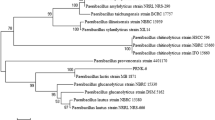Abstract
Four polycyclic aromatic hydrocarbon (PAH)- degrading bacteria, namely Arthrobacter sulphureus RKJ4, Acidovorax delafieldii P4-1, Brevibacterium sp. HL4 and Pseudomonas sp. DLC-P11, capable of utilizing phenanthrene as the sole source of carbon and energy, were tested for its degradation using radiolabelled phenanthrene. [9-14C]Phenanthrene was incubated with microorganisms containing 100 mg/l unlabelled phenanthrene and the evolution of 14CO2 was monitored: within 18 h of incubation, 30.1, 35.6, 26.5 and 2.1% of the recovered radiolabelled carbon was degraded to 14CO2 by RKJ4, P4-1, HL4 and DLC-P11, respectively. When mixtures of other PAHs such as fluorene, fluoranthene and pyrene, in addition to phenanthrene, were added as additional carbon sources, there was a 36.1 and 20.6% increase in 14CO2 production from [9-14C]phenanthrene in the cases of RKJ4 and HL4, respectively, whereas P4-1 and DLC-P11 did not show any enhancement in 14CO2 production. Although, a combination of many bacteria enhances the degradation of organic compounds, no enhancement in the degradation of [9-14C]phenanthrene was observed in mixed culture involving all four microorganisms together. However, when different PAHs, as indicated above, were used in mixed culture, there was a 68.2% increase in 14CO2 production. In another experiment, the overall growth rate of P4-1 on phenanthrene could be enhanced by adding the non-ionic surfactant Triton X-100, whereas RKJ4, HL4 and DLC-P11 did not show any enhancement in growth. Pathways for phenanthrene degradation were also analysed by thin-layer chromatography, gas chromatography and gas chromatography-mass spectrometry. Common intermediates such as o-phthalic acid and protocatechuic acid were detected in the case of RKJ4 and o-phthalic acid was detected in the case of P4-1. A new intermediate, 1-naphthol, was detected in the cases of HL4 and DLC-P11. HL4 degrades phenanthrene via 1-hydroxy-2-naphthoic acid, 1-naphthol and salicylic acid, whereas DLC-P11 degrades phenanthrene via the formation of 1-hydroxy-2-naphthoic acid, 1-naphthol and o-phthalic acid. Both transformation sequences are novel and have not been previously reported in the literature. Mega plasmids were found to be present in RKJ4, HL4 and DLC-P11, but their involvement in phenanthrene degradation could not be established.
Similar content being viewed by others
Author information
Authors and Affiliations
Additional information
Received: 25 May 1999 / Received revision: 16 July 1999 / Accepted: 1 August 1999
Rights and permissions
About this article
Cite this article
Samanta, S., Chakraborti, A. & Jain, R. Degradation of phenanthrene by different bacteria: evidence for novel transformation sequences involving the formation of 1-naphthol. Appl Microbiol Biotechnol 53, 98–107 (1999). https://doi.org/10.1007/s002530051621
Issue Date:
DOI: https://doi.org/10.1007/s002530051621




